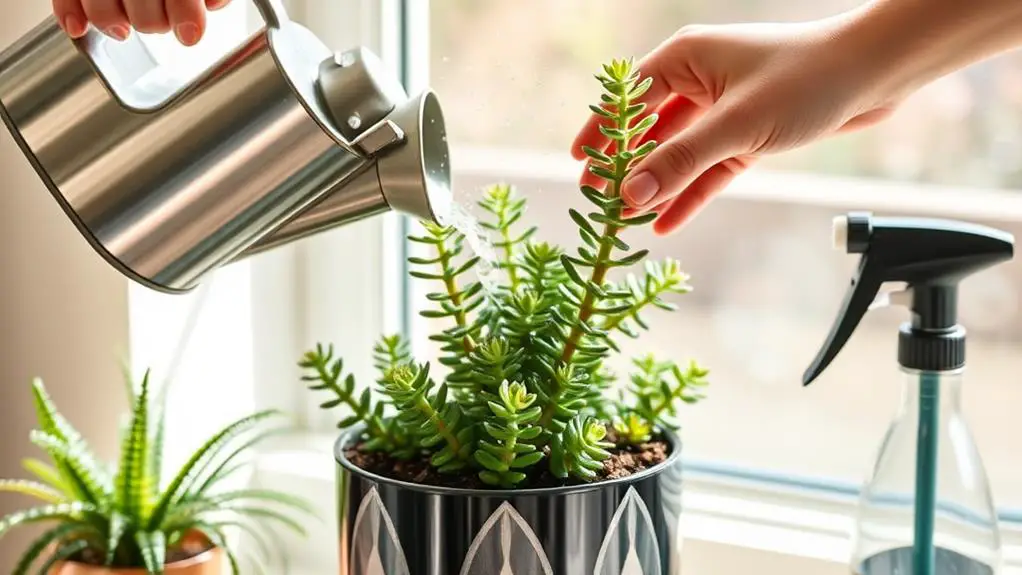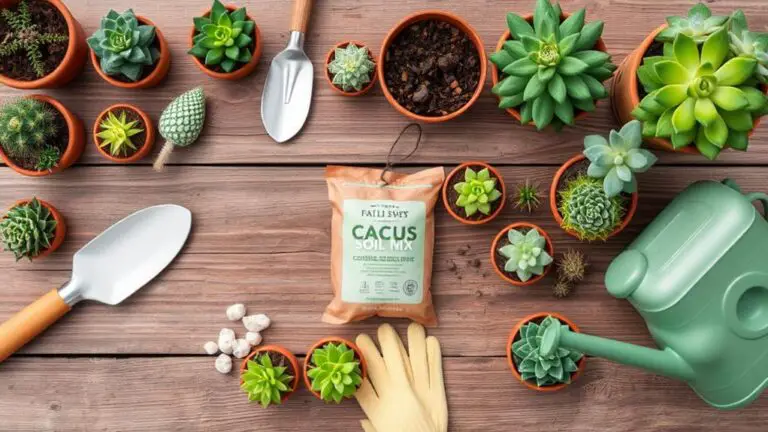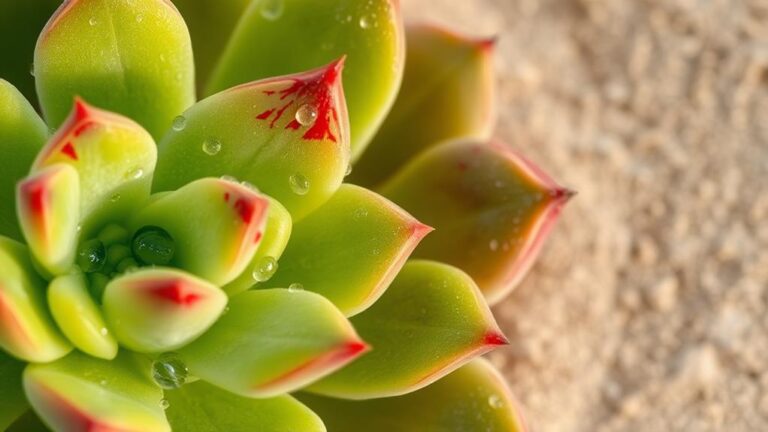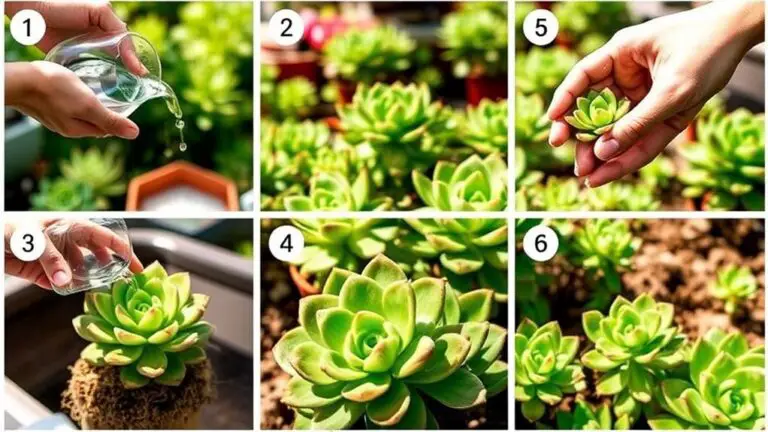7 Steps to Care for Your Crassula Watch Chain Plant
Taking care of your Crassula Watch Chain Plant can seem intimidating, but following seven essential steps will help you guarantee its health and vibrancy. You'll need to take into account its light requirements, soil conditions, watering techniques, and more. First, let's discuss where to place your plant for ideal sunlight exposure. By understanding these needs, you'll set a strong foundation for your Crassula Watch Chain Plant's growth. Curious about the next steps?
Plant Characteristics
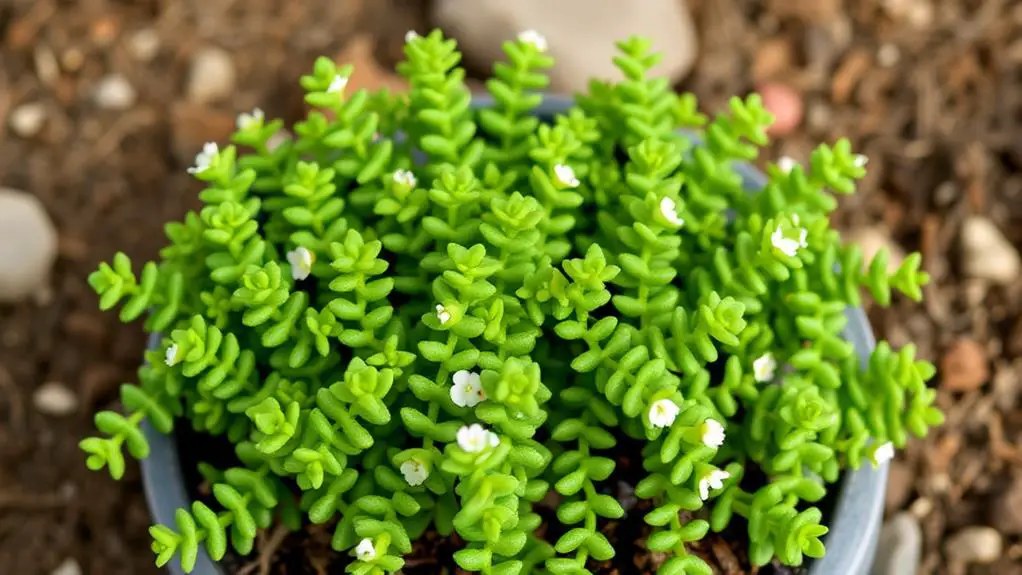
Crassula muscosa, also known as the Watch Chain Plant, grows into a small bush reaching up to 12 inches tall with a distinctive trailing growth habit. If you're looking for a unique succulent to add to your collection, this might be just what you need.
The plant's light green leaves, compactly arranged, create a moss-like appearance that's truly eye-catching, resembling links of a jewelry chain.
This succulent plant produces tiny, pale yellowish-green flowers from spring to mid-summer, adding a delicate touch to its overall look. It thrives best in warmer climates, specifically in USDA Zone 9a, where the lowest temperatures can drop to 20°F (-6.7°C). So, if you live in a region with mild winters, the Watch Chain plant can be a great addition to your garden.
However, be cautious—Crassula muscosa is toxic to animals if ingested. Make sure to place it in a spot that's out of reach of pets.
With its trailing growth habit, this plant works excellently in hanging baskets or as a ground cover, adding both texture and greenery to your space.
Light Requirements
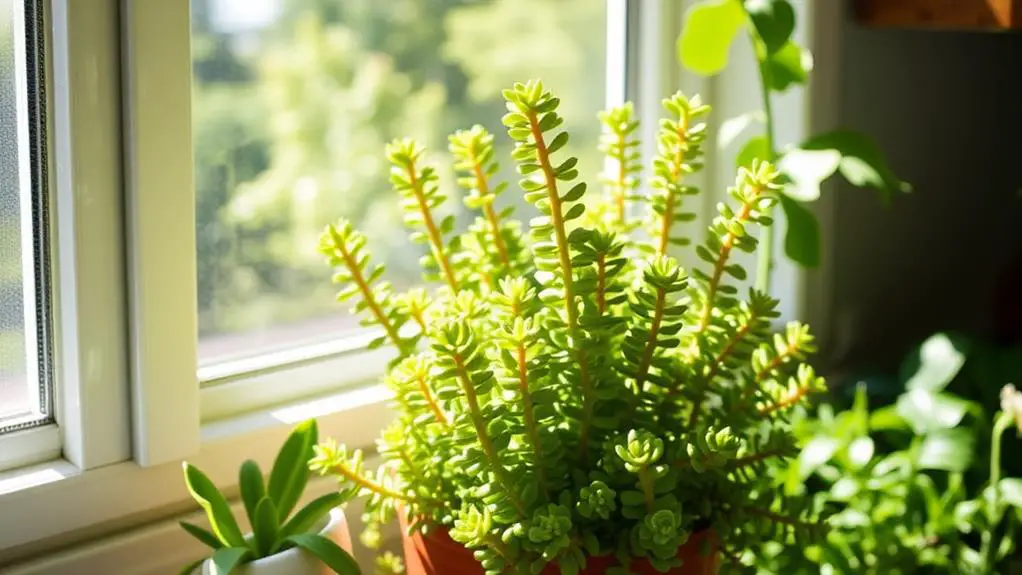
To keep your Crassula Watch Chain Plant happy, you'll want to make sure it gets plenty of light.
Aim for at least 6 hours of bright, indirect sunlight each day, and if you're growing it indoors, a spot near a south-facing window works best.
Gradually introduce it to full sun to prevent sunburn, and adjust its position if you notice it's getting leggy or pale.
Optimal Sunlight Exposure
When caring for a Crassula Watch Chain plant, guaranteeing it gets the right amount of sunlight is essential for its growth. This plant thrives in full sun to partial shade, needing at least 6 hours of direct sunlight daily for peak growth. If it doesn't get enough light, you may notice leggy growth, which makes the plant less vigorous. To avoid this, gradually acclimate your Crassula to brighter conditions.
Indoor placement near south-facing windows can help maximize sunlight exposure. If you're placing your Watch Chain plant outdoors, choose a spot that offers intense sun. However, during the hottest months, especially in summer, monitor your plant for signs of sunburn. If you see any, provide some temporary shading to protect it.
Balancing full sun and partial shade guarantees the best color and health for your plant, particularly in coastal areas where sunlight might be more intense. Here's a quick guide to help:
| Light Condition | Location | Recommended Action |
|---|---|---|
| Full Sun | Outdoor, south-facing | Guarantee at least 6 hours of sunlight |
| Partial Shade | Coastal areas, indoors | Balance sun and shade |
| Intense Summer Sun | Outdoor during summer | Monitor and provide temporary shade |
Indoor Light Placement
Maximizing indoor light placement for your Crassula Watch Chain plant is essential for its overall health and appearance. Crassula muscosa, also known as the Watch Chain plant, thrives in bright, indirect sunlight and needs at least 6 hours of direct sunlight daily for ideal growth.
Placing your plant near a south-facing window is perfect, as this will maximize sunlight exposure, promoting healthy leaves and vibrant colors.
When introducing a new Crassula muscosa to direct sunlight, do it gradually. This prevents leggy growth and helps the plant acclimate properly to its environment.
If natural sunlight isn't enough, consider using grow lights. These can supplement the lighting needs and support growth, ensuring your plant stays healthy and compact.
Proper indoor placement is key to maintaining the plant's compact appearance. Make sure it gets adequate light to avoid stretching.
If you notice your plant starting to stretch or lose its bright green color, it may need more light. Adjusting its position or adding grow lights can help.
Preventing Sunburn Damage**
Ensuring your Crassula Watch Chain plant gets the right amount of light is important, but it's equally essential to prevent sunburn damage. Crassula muscosa thrives best in full sun to partial shade, needing at least 6 hours of direct sunlight daily for ideal growth.
However, sudden exposure can cause leaf scorching, so you'll want to gradually acclimate new plants to direct sunlight. This helps avoid sunburn and keeps the leaves healthy.
To prevent sunburn:
- Monitor the leaves for signs of sunburn, like browning or yellowing.
- Provide shade during extreme heat to protect the plant.
- Use indoor placement near south-facing windows for maximum light with less risk.
- In coastal areas, partial shade can enhance color without intense sunlight damage.
- Adjust light exposure gradually for new plants.
If you notice any signs of sunburn on your plant, consider moving it to a shadier spot or using a sheer curtain to filter the sunlight.
Watering Guidelines
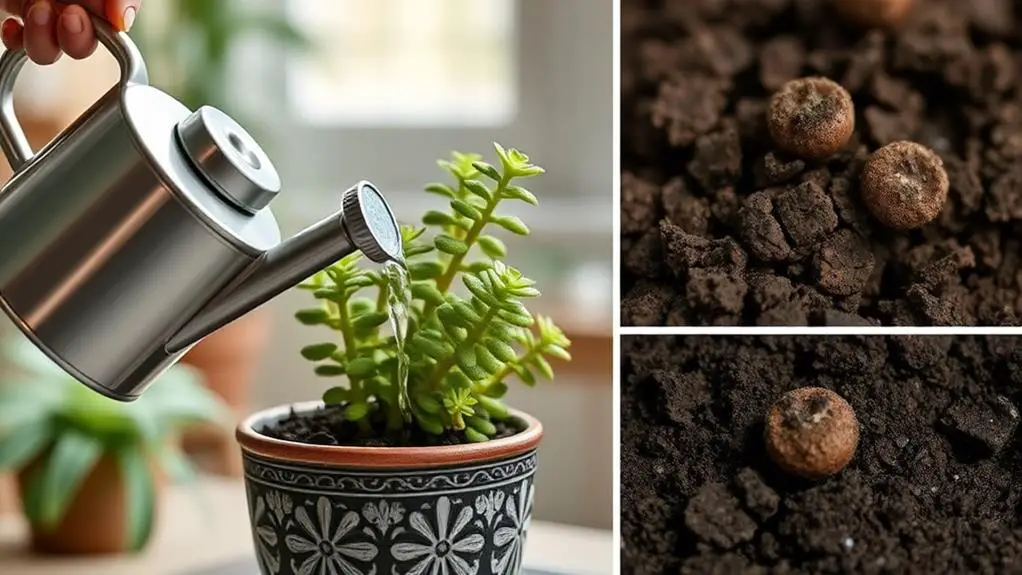
When watering your Crassula Watch Chain Plant, use the soak and dry technique to keep it healthy.
Make sure the soil dries out completely between waterings to prevent root rot, adjusting your schedule based on the season.
In warmer months, you'll need to water more frequently, while in cooler months, you can reduce watering to about once a month.
Soak and Dry Technique
Proper watering is essential for maintaining the health of your Crassula Watch Chain Plant, and the soak and dry technique is one of the best methods to achieve this.
The soak and dry method involves thoroughly watering your plant until water drains out from the bottom. This guarantees the soil is saturated but not waterlogged, preventing root rot. After watering, allow the soil to dry out completely before you water again. Typically, this means watering every 2-3 weeks during the growing season.
To get this technique right, follow these steps:
- Water thoroughly: Pour water until you see it coming out of the drainage holes.
- Check dryness: Use a moisture meter or your finger to check the top 1-2 inches of soil for dryness before watering again.
- Adjust for sun exposure: If your plant is in full sun during summer, you might need to water more often.
- Avoid overwatering: Let the soil dry out completely to prevent root rot.
- Monitor your plant: Keep an eye on your Crassula Watch Chain for any signs of stress.
Don't forget, the frequency of watering can change with the seasons, so always be attentive to your plant's needs.
Seasonal Watering Adjustments
Adapting your watering routine to the changing seasons is crucial for the health of your Crassula Watch Chain Plant.
In the growing season, which includes spring and summer, you should water your Crassula muscosa every 2-3 weeks. Confirm the soil dries out completely between waterings to meet your plant's watering needs. Always check the top 1-2 inches of the soil for dryness before adding water. This prevents overwatering and helps maintain healthy roots.
As temperatures drop and fall arrives, your plant's growth will slow, entering a period of dormancy. During this time, reduce your watering frequency to once every 3-4 weeks. This adjustment accommodates the plant's decreased moisture requirements.
In winter, your Crassula Watch Chain Plant needs even less water. Limit watering to once a month since the plant's moisture needs are minimal during these colder months. Remember, the soil should be dry at least 1-2 inches deep before you water.
If your plant is in full sun during summer, you might need to water more often. Higher temperatures and lower humidity levels can cause water to evaporate faster, making it necessary to monitor soil moisture closely.
Preventing Root Rot
Your Crassula Watch Chain Plant's health hinges on preventing root rot through effective watering practices. To keep your plant thriving, it's important to manage its watering needs carefully. Crassula muscosa requires well-draining soil and the soak and dry method to avoid overwatering. Here's how you can guarantee your plant stays healthy:
- Check soil dryness: Water your Crassula muscosa only when the top 1-2 inches of soil are completely dry. This helps prevent overwatering and root rot.
- Use the soak and dry method: Thoroughly water until excess drains out, then allow the soil to dry completely between waterings. This keeps moisture levels balanced.
- Adjust watering in summer: During the summer months, you may need to water more frequently, but always guarantee the soil dries out fully between each session.
- Guarantee proper drainage: Make sure your pot has proper drainage holes. This prevents water from accumulating at the bottom, reducing the risk of root rot.
- Monitor for signs of distress: Keep an eye out for yellowing leaves or mushiness, which can indicate root rot due to excessive moisture.
Soil Needs
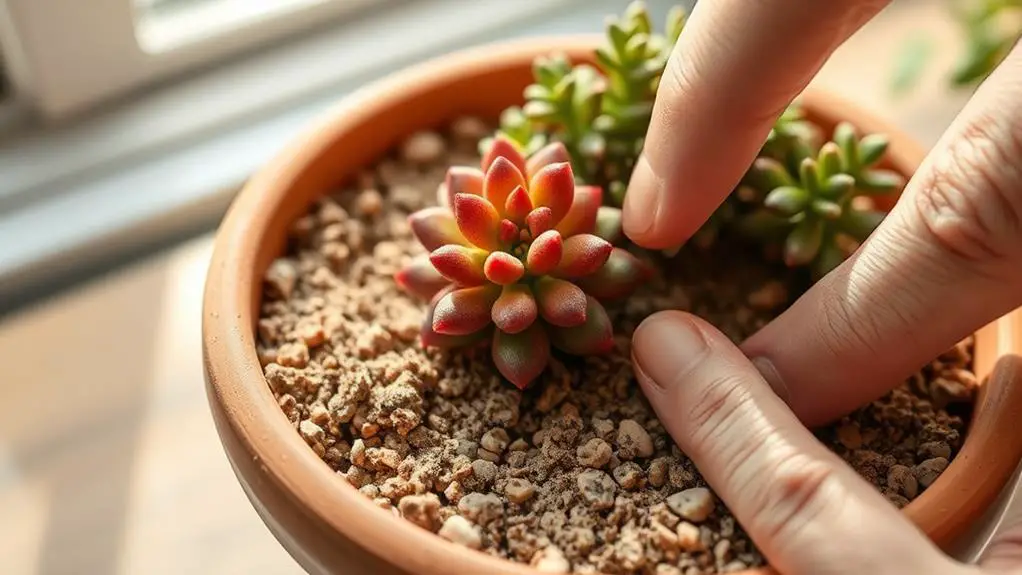
A well-draining soil mix is essential for the health of your Crassula Watch Chain plant. This plant, also known as Crassula muscosa, thrives best in well-drained soil to prevent root rot. You can use a commercial cactus & succulent mix or create your own by combining potting medium, sand, and perlite. Ensuring proper soil drainage helps avoid waterlogging, which can be fatal.
The soil pH should be between 5.6 and 6.5. This range supports ideal growth and nutrient absorption. Regularly check the soil condition, making sure the top 1-2 inches dry out completely between waterings. This prevents overwatering, which can lead to root rot.
When repotting, make sure the soil is dry. Gently shake off the old soil and discard any damaged roots. This helps maintain a healthy root system.
Incorporating organic mycorrhizae into your soil mix can further enhance healthy root development and overall plant vigor. These beneficial fungi improve nutrient absorption, helping your Crassula muscosa grow robustly.
Temperature and Humidity
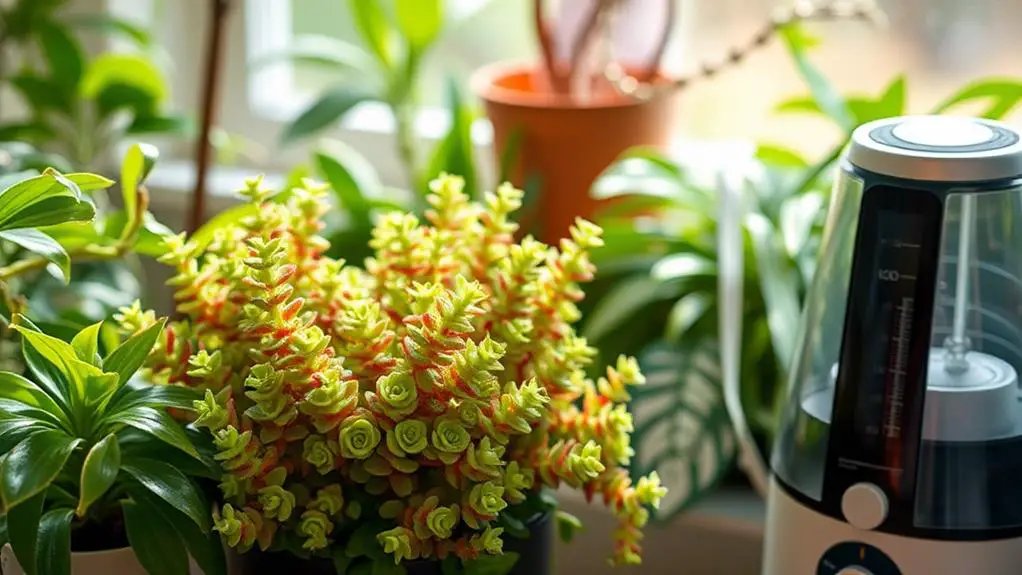
Maintaining the right temperature and humidity is vital for the thriving of your Crassula Watch Chain plant. This unique succulent, also known as Crassula muscosa, thrives in temperatures ranging from 70-75°F (21-24°C) during warmer months.
If it gets hotter, make certain the area is well-ventilated to avoid stress on the plant. During winter, bring your plant indoors if temperatures drop below 41°F (5°C) to keep it healthy.
Humidity is another significant factor. Crassula muscosa prefers humidity levels of 50% or lower. High humidity can cause fungal issues that harm your plant.
Monitoring your local climate conditions can help you decide whether to keep your plant indoors or outdoors, guaranteeing it's in the finest environment year-round.
To summarize:
- Ideal temperature: 70-75°F (21-24°C) during warmer months.
- Cold tolerance: Hardy to approximately 20°F (-6.7°C), but bring indoors below 41°F (5°C).
- Humidity levels: Preferably 50% or lower.
- Ventilation: Guarantee good airflow, especially in high temperatures.
- Monitoring: Regularly check local climate conditions for peak plant health.
Propagation Methods
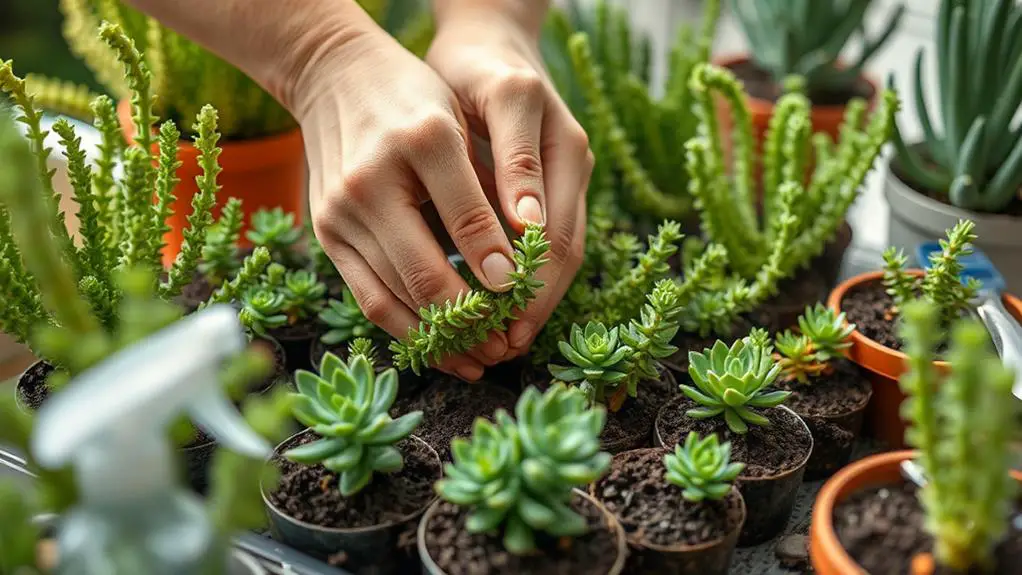
Propagating a Crassula Watch Chain plant is straightforward and rewarding, especially if you're looking to expand your succulent collection. This plant can be easily propagated from stem cuttings taken during the growing season, from early spring to late summer.
Start by cutting a healthy stem segment. Then, let the stem segments callous for at least one day. This step is essential to prevent rot when you plant them.
Once calloused, plant the cuttings in well-draining soil. It's important to water only when the soil has dried out completely. Keeping the soil slightly moist, but not soggy, helps promote healthy root development.
For the best results, maintain an ideal rooting temperature between 68 to 70°F (20 to 21°C). Place the cuttings in a location that has adequate humidity to encourage root growth.
Monitor the cuttings regularly for signs of root growth. As soon as you notice roots forming, the cuttings can be transferred to pots filled with dry, well-draining soil.
This careful attention guarantees your Crassula Watch Chain plant thrives. By following these steps, you'll soon see healthy root development and new growth, expanding your succulent collection effortlessly.
Pest Management
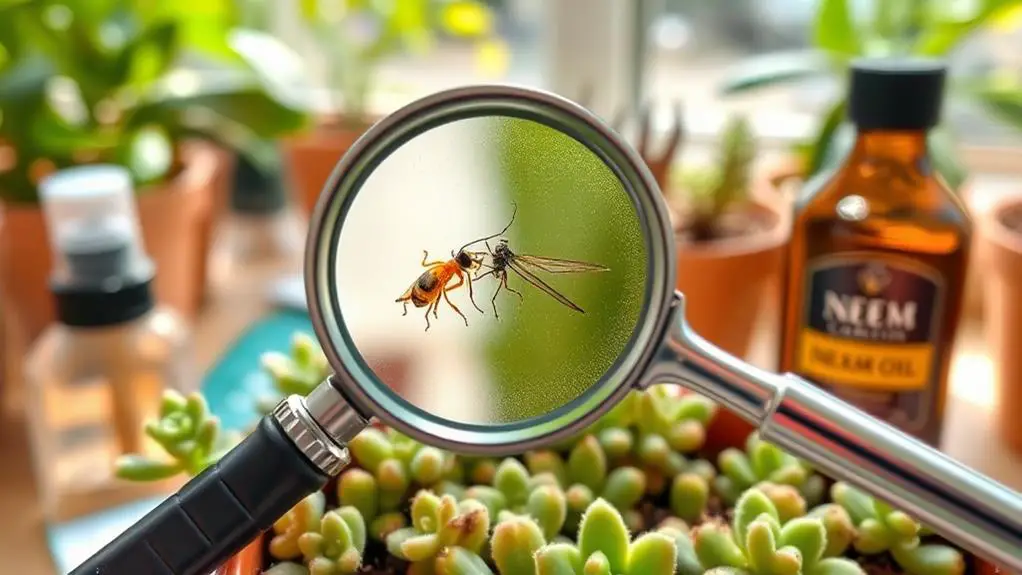
Regularly inspecting your Crassula Watch Chain Plant for common pests is essential to keeping it healthy. Pests and diseases, like mealybugs and spider mites, can affect your plant if not caught early. Check your plant often to spot any issues quickly.
Treat mealybugs by applying 70% isopropyl alcohol directly to them using a cotton swab or cloth. For spider mites, increasing humidity around the plant can help. You can also use insecticidal soap or neem oil to get rid of them effectively.
To prevent root rot and fungal diseases, maintain proper watering practices. Overwatering can weaken your plant, making it more vulnerable to pests. It's also wise to quarantine any new plants before adding them to your collection. This helps prevent potential pest infestations from spreading to your Crassula Watch Chain Plant.
Here's a quick checklist for managing pests:
- Inspect your plant regularly for pests like mealybugs and spider mites.
- Use 70% isopropyl alcohol on mealybugs.
- Increase humidity and use insecticidal soap or neem oil for spider mites.
- Follow proper watering practices to avoid root rot.
- Quarantine new plants before introducing them to your collection.
Frequently Asked Questions
How to Care for a Crassula Watch Chain?
To care for your Crassula Watch Chain, give it at least 6 hours of direct sunlight daily, water using the soak and dry method, use well-draining soil, maintain temperatures between 60°F and 75°F, and check for pests.
How to Take Care of a Crassula Plant?
You'll need to provide your Crassula plant with at least 6 hours of direct sunlight, water using the soak and dry method, use well-draining soil, fertilize during spring and summer, and prune annually for best results.
How Much Light Does a Watch Chain Plant Need?
Your Crassula Watch Chain Plant needs at least 6 hours of bright, indirect sunlight daily. Gradually expose it to direct sunlight to prevent sunburn. If indoors, place it near a south-facing window for ideal growth.
How to Take Care of a Chain Plant?
Water your chain plant using the soak and dry method, letting soil dry between waterings. Guarantee it gets 6 hours of sunlight daily, use well-draining soil, fertilize during growing seasons, and watch for pests like mealybugs.
Conclusion
Caring for your Crassula Watch Chain Plant is easier than you might think! Just remember to give it plenty of indirect sunlight, water it properly, and use well-draining soil. Keep an eye on the temperature and watch out for pests. If you want more plants, try propagating through stem cuttings. By following these steps, you'll guarantee your plant stays healthy and happy. You've got this, and your plant will thrive with your care!

